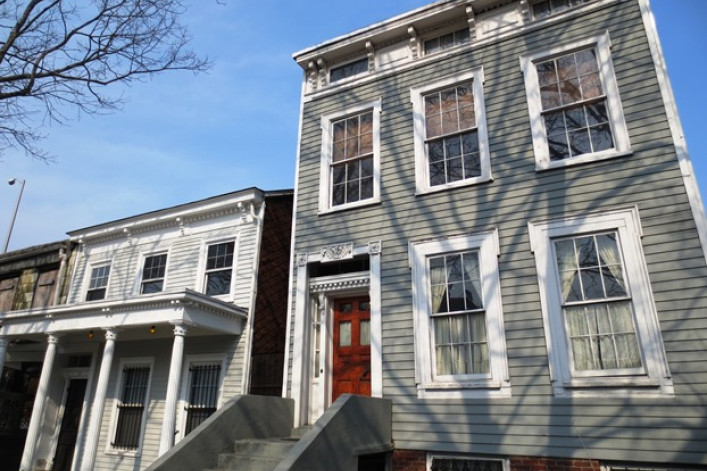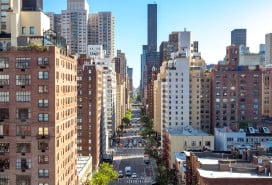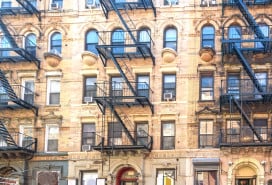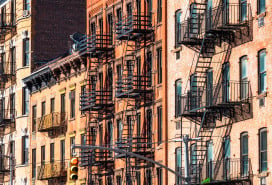Wallabout: 5 things you probably didn't know about one of Brooklyn's most interesting streets

Cynical New Yorkers suspect that the names given to city neighborhoods are all part of a vast conspiracy perpetrated by real estate professionals to boost property prices.
Sometimes they are right. (The South Bronx's Piano District, anyone?) But not when it comes to Wallabout, a name given to a piece of Brooklyn almost 400 years ago by a small group of Walloons, people who escaped Europe via the Netherlands in search of religious freedom.
Although the derivation of the name has been a matter of some disagreement over the years, we’ll settle on the explanation given by local historian Chad Purkey, the Myrtle Avenue Brooklyn Partnership’s director of planning and economic development, that it is a combination of Walloon and the Dutch word "bocht" that translates to bend in the harbor.
Whatever its exact derivation, the Wallabout name, used infrequently over the past few decades, has been resurrected and now refers to a corner of the city bounded by North Portland Street, Classon Avenue, Myrtle Avenue and Flushing Avenue, an area that Douglas Elliman broker Doug Bowen describes as hot—really hot.
In fact, he was willing to go so far as to say that in his opinion, “there’s nothing as hot as Wallabout in Brooklyn right now." Of course, most people don't know it as Wallabout, and refer to it as the edge of Fort Greene or Clinton Hill.
But, here we'll focus not on the larger Wallabout neighborhood, but rather the small Wallabout Historic District, a block of Vanderbilt Avenue between Park and Myrtle that's the ultimate eye candy for fans of 19th century Brooklyn architecture.
Granted official landmark status in 2011 after a long, hard campaign by local residents, preservationists and community groups, this one short block boasts an extraordinary mix of clapboard homes that predate the city’s 1852 ban on wooden homes (for fear of fire) and splendid examples of just about every style of NYC architecture of the post-Civil War period. (The oldest house on the block is number 73, built in the 1830s, shown below.)

The oldest house on the street. Rich Caplan
The District was never the site of any of the city’s truly grand homes; the wealthy preferred somewhat higher ground (they always do because it's less noisy and smelly), so they built their homes a few blocks away on Clinton or Clermont Avenues, such as the still-standing Lefferts-Laidlaw house at no. 136 Clinton Avenue.
The residents of Vanderbilt Avenue had houses that were more modest. Many of the folks who lived on the block in the 1800s worked at the Navy Yard—an easy enough commute. They were, according to a landmark designation report from the city's Landmarks Preservation Commission, which served as a source for this piece, caulkers, brushmakers, woodturners, cabinet makers, joiners, weighers and gaugers, ship chandlers and carpenters according to early real estate records.
Others—clothiers, bookkeepers, harness makers, artists, publishers, booksellers and doctors—had somewhat longer commutes, usually to downtown Manhattan. For them, Wallabout was the suburbs. The homes they lived in were in the Greek Revival, Gothic Revival, Italianate and English cottage style—a textbook mix of the most popular styles of the day.
At first, the homes in the historic district were built for single families but after the Civil War, when Brooklyn’s population soared, the Brooklyn Navy Yard prospered, and the Myrtle Avenue El was built, demand increased and homes were built to accommodate more than one family. Not surprisingly, land prices escalated so savvy builders put up homes that were narrower and taller and on smaller plots of land than the earlier ones.
Nos. 76-78 Vanderbilt Myrtle Avenue Brooklyn Partnership
Note: From May to October, the Myrtle Avenue Brooklyn Partnership offers walking tours of the greater Wallabout area, including a stroll down Vanderbilt Avenue. Led by the Partnership's Chad Purkey, the usually-sold-out tours are free and will take you by Chad’s favorites: the two Italianate beauties, numbers 127 (shown below) and 129.

127 Vanderbilt Avenue Rich Caplan
Now, onto some lesser known facts about Wallabout:
1.The richest man in Brooklyn built five brownstones on the block in 1878.
Usually, houses were built on spec in 19th century New York and often it was successful businessmen who commissioned the projects. The man who built the row of houses numbered 80 to 86 Vanderbilt Avenue was Charles Pratt, who lived on nearby Clinton Avenue in a Neo-Grec style mansion designed by architect Ebenezer L. Roberts. Pratt chose Roberts to draw the plans for his Vanderbilt Avenue project and Roberts decided to use brownstone for the facade, at that time the material of choice for Brooklyn row houses.
Pratt, for whom nearby Pratt Institute is named, made his fortune as founder of the Astral Oil Company which became an early component of the Standard Oil Corporation.
2. Being in a landmark district can’t always save an historic home.
In 1849, Richard Pease, a wood turner, bought a parcel of land on Vanderbilt and built two identical houses side by side—numbers 69 and 71. Pease kept one for himself and sold the other. They had clapboard siding, Greek Revival entrances with sidelights and transoms, and a front porch that stretched the full width of the house. As the years passed, successive owners were typical of other residents of the block in the late 1800’s—middle-class skilled workers who were employed at the Navy Yard.
After World War II, when much of the work at the Navy Yard shrank, the homes began to fall into disrepair. The creation of the the Brooklyn Queens Expressway right next to the structures exacerbated the decline. Both homes fell into disrepair but for number 71, the story has a happy ending, according to Brownstoner: A master builder bought and restored it, painted the clapboard siding and renovated the interior.
Number 69 wasn't so lucky: Over the past five decades, it had become a neighborhood eyesore. The porch had crumbled, the windows boarded up. In 2009, the owner was evicted when the Department of Buildings deemed the house unsafe after it was discovered that the foundation had been compromised by the blasting for the BQE. The owner refused to make repairs and insisted that he be paid $3 million for the house, not a penny less. Last January, according to Curbed, it was torn down.
Myrtle Avenue Brooklyn Partnership
3. The first Jewish professional baseball player grew up at 123 Vanderbilt Avenue.
Dutch-born Emanuel Pike, a Jewish clothing merchant, lived with his wife and 10 children at number 123, although he owned 131 down the block. Three of his children, Boaz, Lipman and Israel, loved baseball and all eventually played professionally. In 1866, "Lip" became one of the first professional players ever and the very first professional Jewish player, when he was paid $20 a week to play for the Philadelphia Athletics. Israel, who preferred to be called Jay, also became a pro player in 1877.
4. The homes on this block may be old but what lies underneath is way, way older.
About nine years ago, a contractor who was digging a sewer line on the block, snagged a 10-ton rock with his excavator. A geologist for the Department of Environmental Protection was summoned and declared the rock from the most recent ice age. The age of the rock: 400 million years. Four more similar but smaller rocks were uncovered in the course of the sewer dig, all identified as Ravenswood granodiorite, which makes up much of the bedrock off the northern shore of Queens.
5. Celebrities are just like us—they want to live in Wallabout.
Although celebs like to keep a low profile, sometimes city records give them away. According to the Brooklyn Eagle, City Finance Department records reveal that artist Kara Walker bought a brick rowhouse on the block for just under $1 million four years ago and Lake Bell bought one across the street from Walker for $1.55 million in 2013.
Bowen has rented apartments in several Wallabout Historic District homes—one in number 73 that has a “parking lot sized garden next to it.” He says that one-bedrooms on the block start at about $2,200.

If you want to live on the historic block but are okay with a not-so-historic house, check out the current rental at no. 115 (shown above), a four-story condo building built in 1991. The rent is $2,800 for a two- bedroom duplex with one-and-a-half baths and 1,300 square feet.



























